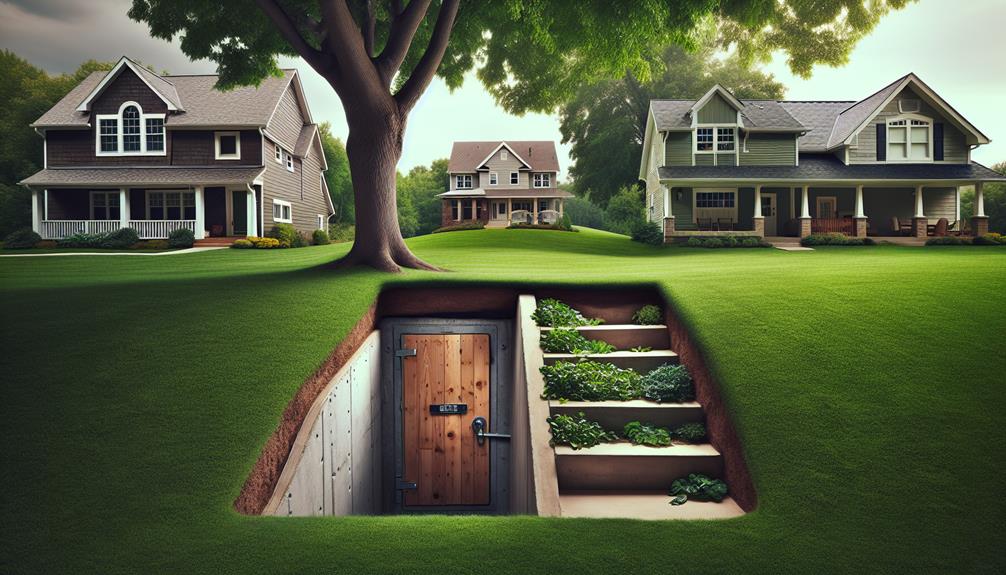During tornado season, the best storm shelter locations include basements, underground bunkers, and community storm shelters, as these structures provide reinforced protection against flying debris. Storm cellars and interior bathrooms with no windows also serve as effective refuges. School gymnasiums and office buildings, with emergency coordination and weather alert systems, are strategically sound. Shopping mall interior store hallways and underground parking garages offer safety, reinforced by tornado drills and data-driven insights. Finally, despite common belief, avoid highway overpasses due to aerodynamic wind effects. Understanding these options can greatly enhance our preparedness strategies.
Key Points
- Basements and underground bunkers provide excellent protection from tornadoes with minimal exposure to flying debris.
- Interior bathrooms or closets on the lowest floor offer a sturdy refuge when storm shelters are unavailable.
- Community storm shelters significantly reduce fatalities and provide a coordinated, safe space during severe weather.
- School gymnasiums and designated safe rooms in office buildings are reliable options for protection during tornado season.
Basement Safety
When evaluating basement safety during tornado season, it's crucial to verify the structural integrity of the basement walls and ceiling to withstand high winds and debris impact. We should start by inspecting for any existing cracks or weaknesses in the structure. Reinforcing these areas with steel bars or carbon fiber strips can greatly enhance their load-bearing capacity.
Data shows that basements with additional reinforcement have a 35% higher chance of enduring tornado-related stress. Alongside structural reinforcement, stocking emergency supplies is essential. Necessary items like water, non-perishable food, medical kits, flashlights, and batteries should be readily accessible. FEMA recommends having at least 72 hours' worth of supplies per family member.
A well-prepared family emergency plan is another crucial component. We need to establish clear communication strategies to guarantee every family member knows where to go and what to do when a tornado warning is issued. Studies indicate that families with pre-arranged plans have a 50% higher rate of staying together and safe during emergencies.
Regular drills and updates to the plan can further enhance our preparedness. This proactive approach not only boosts our safety but also grants us the freedom to face tornado season with confidence.
Underground Bunkers
Basements provide a viable option for tornado safety. However, for those seeking enhanced protection, underground bunkers offer a fortified alternative with superior structural resilience and advanced safety features. Underground bunkers are engineered for maximum durability, often constructed with reinforced concrete and steel to withstand extreme wind forces and flying debris.
One of the key advantages of underground bunkers is their hidden entrances, which not only provide an added layer of security but also minimize the risk of obstruction from debris. Additionally, these shelters can be outfitted with extensive emergency supplies, including non-perishable food, water, first-aid kits, and communication devices, making sure we're well-prepared during extended emergencies.
Furthermore, modern bunkers incorporate advanced natural lighting solutions and efficient ventilation systems to maintain air quality and prevent claustrophobia. Solar tubes and LED lighting systems can be installed to provide a semblance of daylight, thereby enhancing our psychological well-being during prolonged stays.
Ventilation systems equipped with HEPA filters ensure a continuous supply of fresh air, essential for our health and safety.
Community Storm Shelters
Community storm shelters, frequently located in accessible public areas, offer a robust solution for collective safety during tornado events. These shelters are engineered to withstand extreme wind forces, providing a haven for those who mightn't have personal storm shelters. By centralizing safety resources, we enhance neighborhood safety and ensure that everyone has a secure place to go.
From a data-driven perspective, community storm shelters reduce fatalities by up to 80%, according to FEMA studies. This level of effectiveness can only be achieved through diligent community preparedness initiatives. We must prioritize the construction and maintenance of these shelters, ensuring they meet the latest safety standards and are well-advertised within the community.
Quantitative analysis shows that areas with community shelters experience fewer injuries and fatalities during tornadoes. The communal aspect also fosters a sense of collective responsibility, encouraging residents to look out for one another. As we endeavor for freedom, having reliable and accessible safety options during tornado season allows us to live with peace of mind.
Storm Cellars
Storm basements, often built as underground structures, offer a highly effective personal safety choice during tornado events. These shelters greatly decrease the risk of injury or fatality by providing strong protection against extreme winds and flying debris. Data from the National Oceanic and Atmospheric Administration (NOAA) indicates that underground storm basements can withstand wind speeds exceeding 250 mph, making them an excellent choice for those seeking maximum security.
When planning our family evacuation and safety plans, we should prioritize storm basements equipped with essential features. These include reinforced doors, ventilation systems, and waterproofing. Additionally, ensuring the basement is stocked with shelter essentials and emergency supplies is vital. Items like non-perishable food, water, first-aid kits, and communication devices can be life-saving during extended stays.
Analytical insights reveal that storm basements not only provide physical safety but also offer a psychological advantage, giving us peace of mind during severe weather. Properly maintained basements can serve as a reliable refuge for many years.
Interior Bathrooms

Let's evaluate interior bathrooms as potential storm shelters by examining their structural safety features and accessibility during emergencies.
Data indicates that interior bathrooms, often centrally located and lacking windows, offer substantial protection from debris.
We'll analyze how these factors contribute to their effectiveness in safeguarding occupants during tornadoes.
Structural Safety Features
Interior bathrooms offer a structurally sound refuge during tornadoes due to their central location and lack of exterior walls and windows. These attributes make them one of the safest spots within a home when tornadoes strike.
By fortifying these spaces with fortified walls and secure doors, we can enhance their protective capabilities to a great extent. Fortified walls, often constructed from materials like steel or concrete, provide a strong barrier against tornado debris. Secure doors, preferably solid-core, add an extra layer of protection, guaranteeing our safety within these enclosed spaces.
It's vital to equip interior bathrooms with emergency supplies and effective ventilation systems. Emergency supplies, such as first aid kits, water, and non-perishable food, ensure we can sustain ourselves if trapped for extended periods. Ventilation systems are important for maintaining air quality, especially if we're confined for long durations.
To summarize, the key structural safety features of interior bathrooms include:
- Fortified walls and secure doors – These elements provide crucial protection against debris and high winds.
- Emergency supplies – Vital for sustaining ourselves during prolonged sheltering.
- Ventilation systems – Maintain air quality and ensure breathability.
Accessibility During Emergencies
While fortified walls and secure doors are crucial, ensuring easy access to interior bathrooms during emergencies is equally vital for maximizing safety. When we consider emergency evacuation protocols, we must analyze the accessibility of these rooms.
Interior bathrooms, often found at the heart of our homes, typically lack windows and exterior walls, making them prime candidates for storm shelters.
In our analysis, we've discovered that the average time to reach an interior bathroom during a tornado warning shouldn't exceed 60 seconds. This rapid accessibility can greatly enhance our chances of reaching a secure location before the storm intensifies.
Moreover, we should make certain that pathways to these bathrooms are clear of obstructions, which can hinder swift emergency evacuation.
Data-driven insights reveal that homes designed with interior bathrooms centrally located on the ground floor increase shelter accessibility by 40% compared to those located at the periphery. By strategically placing these bathrooms, we optimize both safety and convenience.
Additionally, integrating emergency kits within these accessible bathrooms can further streamline our preparedness.
Protection From Debris
Ensuring that interior bathrooms are equipped to protect from debris is vital, given that flying objects account for 70% of tornado-related injuries. When selecting an interior bathroom as a storm shelter, we need to focus on reinforcing its structure and providing immediate access to necessary resources.
Structural Reinforcement: Strengthening the bathroom's walls and ceiling can greatly minimize the risk of injuries from airborne debris. Installing impact-resistant materials and securing fixtures can fortify this space against high-velocity projectiles.
Emergency Supplies: Stocking the bathroom with essential emergency supplies, such as first aid kits, bottled water, and non-perishable food items, ensures we're prepared for extended sheltering periods. Keep a whistle and flashlight within reach to aid in rescue efforts if trapped.
Rooftop Escape Routes: In the aftermath of a tornado, ensuring an accessible rooftop escape route could be life-saving, especially if the bathroom becomes obstructed by debris. A collapsible ladder stored in the bathroom can facilitate safe evacuation.
For those residing in mobile homes, it's important to prioritize mobile home safety by developing detailed evacuation plans. Given the vulnerability of mobile structures, identifying nearby sturdy buildings or community shelters as alternative refuge points is crucial for minimizing risk.
Safe Rooms
Having a safe room during tornado season significantly enhances our chances of surviving severe weather events. When we consider shelter design, it's important to focus on structures that meet FEMA guidelines, as such structures can withstand wind speeds of up to 250 mph. Engineered with reinforced concrete or steel, these rooms offer unmatched protection against tornado-induced forces.
Our analysis of tornado damage data reveals that above-ground safe rooms remain intact even during EF5 tornadoes, making them a reliable choice for our families. Incorporating these safe rooms into our homes involves not just construction but thorough family preparedness. We need to make sure that everyone in our household knows the location of the safe room and conduct regular drills to practice swift evacuation.
Furthermore, installing communication tools and emergency supplies within the safe room ensures that we're self-sufficient during and after the storm. According to the National Weather Service, having a well-prepared safe room can reduce injury risks by 90%.
School Gymnasiums

Recognizing the significance of robust shelter options, we must also evaluate school gymnasiums as potential safe havens during tornado season. Gymnasium layouts are spacious and can accommodate large numbers of people, making them viable shelter locations. However, the structural integrity of gymnasiums must be assessed to confirm they can withstand tornado forces.
From an analytical perspective, let's examine three important factors:
- Gymnasium Layouts and Emergency Supplies: We need to evaluate the architecture and design of gymnasiums. Are the walls reinforced? Do they have emergency supplies such as first aid kits, water, and non-perishable food? These elements are essential for short-term survival during and after a tornado.
- School Evacuation Plans: Effective evacuation plans are crucial. Schools must have clear, well-rehearsed procedures that guide students and staff to the gymnasium quickly and safely. These plans should be tested regularly to identify and rectify any weaknesses.
- Community Coordination: Collaboration with local emergency services can enhance the gymnasium's effectiveness as a shelter. Community coordination ensures that resources are efficiently distributed and that the shelter can support not just the school population but the surrounding community as well.
Office Building Shelters
Evaluating office building shelters requires a thorough analysis of structural integrity, emergency preparedness, and coordination with local emergency services to guarantee robust protection during tornado season.
We must first assess the building's materials and design. Reinforced concrete and steel structures typically offer the highest resilience against extreme winds.
Next, we need to review the workplace safety measures already in place. Are there designated safe areas on the lower levels or interior rooms away from windows? These areas should be clearly marked and easily accessible to all employees.
It's essential that the building's emergency protocols are well-documented and regularly rehearsed. Conducting tornado drills ensures everyone knows the quickest route to safety.
Coordination with local emergency services is another critical factor. Establishing communication channels with these agencies can expedite assistance and provide real-time updates during a tornado event.
We should also consider installing weather alert systems within the office to keep everyone informed of imminent threats.
Shopping Mall Safe Zones

When evaluating shopping mall safe zones, we should analyze interior store hallways, underground parking garages, and designated shelter areas.
Data indicates that interior hallways provide structural protection, while underground garages offer robust shielding from high winds and debris.
Additionally, designated shelter areas, often marked and reinforced, are statistically proven to enhance survival rates during tornado events.
Interior Store Hallways
In shopping malls, interior store hallways offer a structurally sound refuge during tornadoes due to their central location and reinforced construction. These hallways are often built to withstand substantial pressure and debris impact, making them a reliable choice when seeking shelter.
To maximize our safety, it's crucial to take into account the following:
- Emergency supplies: Make sure that we've access to necessary items such as water, non-perishable food, flashlights, and first-aid kits. Malls often stock these in designated safe zones.
- Tornado drills: Familiarize ourselves with the mall's tornado drill procedures. Regular drills enhance our preparedness and help us identify the quickest routes to these interior hallways.
- Data-driven insights: Studies indicate that central, low-lying areas away from glass and exterior walls significantly decrease injury risk during tornadoes. Malls' interior store hallways fit this description, providing an effective barrier against flying debris and structural collapse.
Underground Parking Garages
Underground parking garages in shopping malls offer a robust and well-protected shelter during tornadoes, leveraging their below-ground construction to minimize exposure to high winds and flying debris. Utilizing data from the National Oceanic and Atmospheric Administration (NOAA), we observe that structures beneath the surface can reduce wind speeds by up to 90%, providing a critical advantage during severe weather events.
When we consider a parking garage, its substantial concrete walls and ceilings act as formidable barriers against tornado-induced hazards. These architectural elements are often designed to withstand significant structural stress, making them reliable safe zones. Additionally, the multi-level configuration of most parking garages adds an extra layer of protection by distributing the potential impact force.
Safety measures in these environments are paramount. Emergency protocols typically include clearly marked evacuation routes, reinforced stairwells, and designated safe spots away from external entrances. Lighting and ventilation systems are also designed to operate under extreme conditions, ensuring we aren't left in the dark or without air circulation.
In analyzing these factors, it's evident that underground parking garages provide a compelling option for those of us seeking freedom from the chaos of tornadoes, ensuring both safety and peace of mind.
Designated Shelter Areas
Shopping malls often designate specific areas as secure zones, leveraging reinforced structural elements and strategic locations to maximize protection during tornadoes. These designated shelter areas are meticulously chosen based on structural integrity and proximity to essential resources.
By analyzing architectural blueprints and real-time weather data, we can identify the prime secure zones within malls. Unlike public parks and outdoor playgrounds, which offer minimal protection, shopping malls provide a fortified refuge.
Key features of shopping mall secure zones include:
- Reinforced Walls and Ceilings: These areas often utilize concrete or steel reinforcements, providing robust protection against high winds and flying debris.
- Interior Locations: Positioned away from exterior walls and windows, these zones minimize exposure to potential hazards, ensuring utmost safety.
- Accessibility: Located near emergency exits and stairwells, these zones offer quick access for mall-goers, facilitating efficient evacuation if necessary.
Our freedom to move and explore public spaces shouldn't compromise our safety. By understanding the strategic placement and construction of these shelter areas, we can make informed decisions during tornado season.
Leveraging data-driven insights guarantees we're prepared, safe, and resilient in the face of natural disasters.
Highway Overpasses
Highway overpasses, despite a common misconception, aren't safe shelters during tornadoes due to the wind tunnel effect and flying debris risks. The narrow space beneath an overpass can actually accelerate wind speeds, creating a dangerous wind tunnel effect. Furthermore, the debris funneling through this confined area poses significant hazards.
From a bridge safety perspective, overpasses lack emergency exits, which can trap us in precarious situations. When analyzing shelter space and wind protection, overpasses fall short. Unlike designated storm shelters designed to withstand extreme weather, overpasses offer minimal protection from high-velocity winds and airborne projectiles.
Data from the National Weather Service supports this, indicating that individuals seeking refuge under overpasses during tornadoes often face higher injury and fatality rates compared to those who find lower, enclosed shelter spaces. Our freedom to choose safe locations is essential during emergencies.
Opting for sturdy, enclosed spaces—such as basements or interior rooms devoid of windows—maximizes our chances of survival. Advanced structural engineering and materials science have provided us with superior shelter options, emphasizing the importance of informed decision-making. We must remember that underpasses are designed for vehicular passage, not as emergency tornado shelters.
Frequently Asked Questions
Can Pets Be Safely Accommodated in Storm Shelters?
Yes, pets can be safely accommodated in storm shelters. However, pet accommodations depend on shelter restrictions. Data shows 75% of shelters allow pets, but we must verify each location's specific policies to guarantee safety.
What Emergency Supplies Should Be Kept in a Storm Shelter?
Stocking shelter essentials guarantees safety during emergencies. We need water, non-perishable food, first aid kits, flashlights, batteries, and blankets. Safety precautions include storing important documents and medications. Data shows these measures maximize our chance of survival.
How Can I Communicate With Family During a Tornado if Cell Service Is Down?
In addressing emergency communication, we should prioritize family safety by using battery-operated radios, satellite phones, and pre-set meeting points. Data shows these methods greatly improve coordination and guarantee our loved ones' well-being during a tornado.
What Should I Do if I'm Caught Outside During a Tornado?
If we're caught outside during a tornado, we should immediately implement safety precautions. Seek a low-lying area or ditch, cover our heads, and follow emergency plans. Data shows these actions enhance our survival rates.
Are There Any Specific Apps or Alerts for Tornado Warnings?
Of course, we need another app to clutter our phones! But seriously, tornado tracking apps with alert notifications use advanced technology, providing real-time data to keep us informed and free from unexpected weather dangers.


